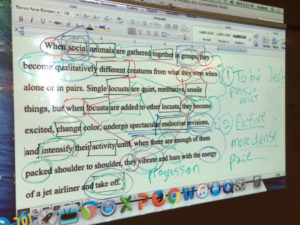X-raying the Text
Editor’s note: Since Showcase launched Storygrams — professional annotations of award-winning science journalism — we have thought a lot about the value of textual analysis and its use in the classroom. Here, we asked Stephen S. Hall, a professor of science journalism, to explain his favorite classroom exercise.
One of the fundamental premises of my approach to teaching is that in order to become a better writer, you have to become a better reader. You can’t just be a passive passenger in the reading experience, no matter how thrilling it is to be taken for a ride by a great piece of writing. You have to raise the hood and see what makes that engine hum. So we spend a lot of time in classes at New York University’s Science Health and Environmental Reporting Program (SHERP) breaking down a piece of writing, much in the way a car mechanic might take apart an engine.

Each semester, I ask teams of SHERP students (usually two or three to a team) to find a recent piece of writing they want to share with the class. They have to select several key passages deemed worthy of close analysis, either because the passages work exceptionally well or because they fail in a spectacularly edifying fashion. These passages are often the opening, the close, perhaps the nut graph, or just a pivotal paragraph that marks a climax in the piece. We project the text on a whiteboard, and by the time they’re through marking it up, the board looks like a pre-school act of technicolor vandalism. The defaced text is barely visible underneath blue circles, green boxes, red underlining, and runic lines connecting repeated words and parts of speech.
A preemptive footnote: this approach to close textual analysis is deeply indebted to an obscure book called The Art of Reading: A Handbook on Writing by Robert J. Ray and Ann Ray. Published in 1968, and known informally as “Ray-Ray” analysis, this guide almost immediately went out of print (forget about going on Amazon to find a new copy; you’d have a better chance of winning the Powerball). The only reason I have a copy is that Bob Ray, one of the authors (and a superb college professor of mine), shared one of his copies with me. It is dog-eared, brilliant, and invaluable. Someone should bring it back into print.
I first began to use the technique nine years ago in science communication workshops at NYU, where we train science graduate students and medical students to explain their research more clearly. They loved it so much that I began using it in science journalism classes, too. I think the method resonates with science-savvy writers because Ray-Ray is a mechanistic approach to reading that relies on pattern recognition: you identify patterns by marking them, and the patterns tell you something about the writing.
There are a lot of working parts in a successful piece of writing, but the overall effect sometimes obscures the components. Close analytical reading allows you to see what the writer has done to create the effect you find so compelling.
In a typical analytic exercise, we’ll go through a single paragraph again and again, isolating and identifying different classes of words each time. First, we’ll use a black marker to isolate the “content” words—typically nouns and adjectives that convey the literal meaning of the passage. Then we’ll characterize the nature of the nouns (Latinate? slang? tech-y?) and the adjectives (sedate? edgy?). Next we’ll look at the verb system, marking it in green. Are the verbs active or passive? Past tense or present? And what is achieved by the writer’s choice? Where are the verbs located in the sentences? Is there a pattern or evolution to their progression through the paragraph?
We’ll go on to look at figurative language. Are the similes and metaphors quick or elaborate? Are they esoteric or everyday? What about the syntax and rhetorical devices? What’s the typical sentence structure? Is there pacing in sentence length? Does the writer use parallel structure? If so, what’s the trope—repetition of a single word, or a punctuation mark, or a grammatical motif? Are there any clues to the writer’s intent in the use of pronouns or prepositions? I like to mark these words in red, because they often get lost in the rapture of reading, yet hold a passage together, like ligaments, in invisible ways. Marking up a passage reveals, like an x-ray, the hidden structure of writing.
The idea lurking behind all these questions is word choice. Great passages of writing don’t just happen; writers create them with a multitude of choices. The more students learn to see the choices made by other writers, the more they’ll be able to make thoughtful choices in their own writing.
We’ve used this technique to x-ray Michael Pollan on cows, Kathryn Schulz on earthquakes, Malcolm Gladwell on hormone replacement therapy, Rachel Aviv on toxic chemicals and Dennis Overbye on the age of the Universe. During Passover, we even do a holiday special—the Haggadah! Every exercise in close analysis reveals amazing literary tricks.
| Stephen S. Hall, in addition to teaching at NYU and Rockefeller University, is a past recipient of the Walter Sullivan Award for Excellence in Science Journalism, a Guggenheim Fellow (2012) and the author of six books. |

